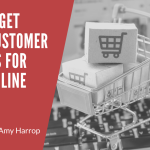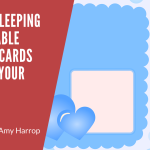
Today’s Guest Post is From Karon Thackston,
If I’ve heard it once, I’ve heard it 1,000 times: “How do I know which low-content products to create? I make them, but nobody buys.”
The short answer is: Ask your customers. Obvious, yes. There is a drawback, however. While customers are the only people who can answer that question, direct communication about which products customers will or won’t buy can be … well … complicated.
That’s not to say you shouldn’t ask. It is to say you should take those answers with a grain (or teaspoon) of salt.
Here are 5 ways you can determine which low-content products your customers are most likely to buy.
1. Ask
Here’s why a direct ask can be confusing. Most people don’t want to hurt anyone’s feelings, so the answer to a “would you buy this” question will always be “yes” for them. Even if the answer is really “no.”
Some people will answer “yes” until they find out what you’ll charge for the product. Then they decide they only want it if it is free.
Using direct-question formats such as:
• Would you buy this product?
• How much would you pay for this product?
Frequently leads to inaccurate data.
There are other ways to ask that tend to provide a bit more reliable results. These include:
Conduct Surveys — SurveyMonkey.com and other sites offer free and paid survey tools that enable you to easily create and administer anonymous surveys. Send your followers the link and they can answer without any fear that you’ll come back later demanding they buy your new product just because they said they might in that Instagram you posted.
Polls — Clicking a multiple-choice answer is less of a commitment than flat-out answering “yes” to a public question. Provide several options at a time and allow your followers to choose the ones they are most interested in.
Online — Check websites to see what information they have. Are there a lot of search results for this type of product on Google? Is it listed in the “People Also Ask” section of the Google SERP (search engine results page)?

If you go to answer websites such as AnswerThePublic.com, are there a lot of questions pertaining to the topic you have in mind?
2. Keyword Research
Keyword research is not only good for search engine optimization (SEO), it’s also a great indicator of intent. This is especially true if you look for keywords that show buyer behavior traits.
For example, searching for “bullet journal” might show an estimated search volume of 165,000. But that doesn’t mean 165,000 people will be ready to buy your low-content bullet journal. They could be searching for the book “The Bullet Journal Method.” They might be looking for articles about how to bullet journal. They may wish they could find an app for bullet journaling.
You could try “download bullet journal,” but most of those bring up listings giving away PDFs. That’s not you.
A bit more research leads us to “buy bullet journal,” with 480 searches. That’s quite a bit lower than just “bullet journal,” but it’s also significantly more targeted. With this term, we know for certain people are expecting to pay money for their product. Have a look at what listings are shown for this term and you can get some great ideas about what people are actually willing to pay for.
3. Pre-Sell
There’s no better indicator of what people will pay for than when they pull out their credit cards and use them! When you pre-sell a product, you generate an outline and a sales page, and that’s all you put up.
Then, with a promise of a discount and the enormous pleasure of being one of the first to own [fill in the blank], you offer exclusive rights to get on the pre-sell list.
After, and only after, you have the number of pre-sales that makes you confident this low-content product is worth your while, do you create the product itself.
Don’t want to go to that much trouble in the beginning? Create a waiting list instead.
The waiting list is similar to the pre-sale technique. It can be used alone or in conjunction with a pre-sale. Create a waiting list that your followers can sign up for to be notified of when a product will be available. While you don’t have to have a formal sales page available, you will want to at least have several feature / benefit bullet points written to explain the product.
Once your sales page has been written you can either (A) pre-sale the product or (B) create the product, then sell it outright.
4. Find & Fill A Gap
Whether you use your keyword research to do it, or you keep an eye toward your competition, your can determine what to include in those products you create by finding and filling gaps.
Do you see keywords with a lot of search volume, but not many relevant results related to low-content products? For example, let’s say you searched for “autism planner” and found it has tons of search volume, but there are no low-content products available for this niche.
You can fill that gap (provided your audience includes parents, teachers, and others who work with autistic people).
Similarly, if you check your competition’s websites, Amazon listings, etc., and find they are not offering low-content options for a particular niche, you can fill that gap with your own products.
5. IMPORTANT —-> Create Customer Profile
If you don’t have a solid understanding of who your target customers are and what they are most interested in, none of these other approaches will help identify the best low-content products to create and sell.
For instance, if your followers / customers are tired of journals, but that’s the only type of low-content product you create, the topic won’t matter.
A customer profile is a simple way to find out more about your target avatar so you can communicate, relate, and respond to their needs. And when you do it right, that always leads to more revenue!
With my Easy Customer Profile Creation course, you will discover simple techniques for drafting your original target audience profile and how to keep it updated and fresh. It’s a professional step toward finding and providing awesome low-content products your customers crave, but it’s also much more.
Customer profiles can be used to:
• Improve the way your prospects envision themselves in your advertising.
• Increase the connection you have with your customers by using words, colors, and more that they respond well to.
• Plan your content to determine topics of blog posts, videos, social posts, and more that your customers will love!
• Choose images that allow your customers to see themselves clearly.
• Write copy in your marketing personas’ language in sales copy, opt-in pages, emails, and more by using the verbiage they use.
• And so much more.
 Get Easy Customer Profile Creation today to improve your low-content product creation and more, and save $10 with code PROFILE.
Get Easy Customer Profile Creation today to improve your low-content product creation and more, and save $10 with code PROFILE.
Teacher. Guide. Simplifier of the complex. Since 1999, Karon Thackston of Marketing Words has been devoted to delivering high-value training that empowers online entrepreneurs to entice, engage & earn through blogging, copywriting, passive income, and more. From blogging to bucks to online biz, Karon breaks down the process into easily understood steps. And she’ll do it will 100% focus, not fluff, so you can entice, engage and earn!




Thanks for sharing, Amy! I hope your readers find the info useful.
This is great! With all the crazy going on I have been looking at low content as an additional income stream. I do FBA, (in addition to my PLR stores), and my FBA coach says ‘find what they want and give it to them’. Which is just crazy enough to work, lol.
I have a few hundred ideas for low content products that I need to sort through and prioritize. I probably should start by defining my customer avatar first., and decide what it is they need.